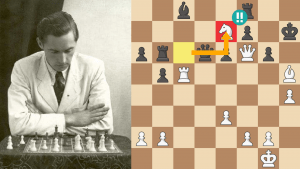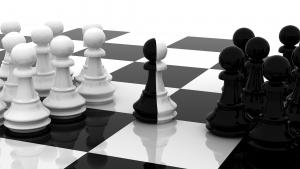
Fighting For Your Chessboard Rights!
IMPORTANT: [At the end of the puzzles, you should click MOVE LIST so you can see my instructive notes and variations. If you are having trouble solving a problem, just click SOLUTION, and then MOVE LIST. Even if you solve everything, DO click MOVE LIST or you might miss an important bit of prose.]
Birdbrain (1603) – opalos (1681), chess.com 3+2, 2012
1.f4 Nf6 2.Nf3 c5 3.e3 Nc6 4.g3 d5 5.Bg2 Bg4 6.0-0 e6 7.h3 Bxf3 8.Qxf3 Bd6 9.d3 Qc7 10.Nc3 a6 11.e4 Nd4 12.Qf2 dxe4 13.dxe4
White made it clear that he was very familiar with this kind of position. Though his position is better, that doesn’t mean Black can’t fight back, milk the positive features in his game, and ultimately prevail. White can expand in the center with e4-e5, and he’s hoping that his light-squared Bishop will eventually lead to something. Black, on the other hand, quickly demonstrates that he doesn’t have a clue.
The reason I’m showing this game (which White easily won) is that it’s a great illustration of one side knowing exactly what he wants to do versus an opponent that reacts to everything, while refusing to settle down and actually create something for his own side. Sadly, the vast majority of amateurs play in this manner, even though most aren’t aware that they are doing so.
Do YOU do this kind of thing? Take an honest look and perhaps you’ll be so horrified at your own reflection that you’ll stop walking down this kind of dead-end road.
13...Nd7?
Black saw the e4-e5 fork, reacted, and ran for the hills. True, it avoids the loss of material, but how does this create something for his side? Also, how does this move affect the minor piece battle?
What should Black have done? In my opinion, the combative 13…e5! is the way to go. Please play over the analysis and see how one should fight for his “rights” in such positions!
14.e5 Be7 15.Ne4 g6?
Another react move that does nothing for his game and, in fact, makes things even worse by creating a hole on f6.
Find a far better plan in the following puzzle!
16.c3 Nc6
Black probably saw ahead of time that his reactionary blunder 15…g6 would have to be followed by the further “run for your life” move, 16…Nc6.
17.Be3 b6
React. After this, queenside castling is no longer on the table due to the wide-open road along the h1-a8 diagonal. I would probably have tried to justify sacrificing the c-pawn first, and if that didn’t work (it doesn’t), then I’d play 17…c4 18.b4 0-0 when black’s much worse, but thanks to moves like …f7-f5 or …f7-f6 or, in some lines, even …g6-g5, Black can mix things up and pray the gods smile down on him.
18.Rad1 0-0 19.Nd6
19…Bxd6?
Having rested for a moment with castling, Black now continues his plan of reacting to everything he can. This world class reacting move (which almost prompted me to title this article, CHESS MASOCHISM: THE ART OF THE FULL-BOARD GROVEL) hands White the d-file, forces his other Knight to a prone position on b8, and gives White two bishop vs. two Knights. Like it or not, 19…Rad8 had to be played. Now Black is dead lost.
20.Rxd6 Ndb8 21.Rfd1 and Black, who has skillfully left himself bound hand and foot, went down without a fight. On the other hand, Birdbrain showed extraordinary chess powers.
Lessons From This Game
* If you fight tooth and nail to push your own agenda, then you can often turn an inferior position into a triumphant one.
* At the very least, create chances for yourself (based on the imbalances, of course). Even if your game is worse, your determined and logical moves will force the opponent to play at a very high level to prove his superiority.
* If you see yourself reacting to an enemy threat, plan, or idea, stop and think long and hard about using what your position offers. If it doesn’t offer anything, then find a way to create something (even if that calls for a sacrifice).
HOW TO PRESENT A GAME FOR CONSIDERATION
If you want me to look over your game, send it to [email protected]
I need your name (real or chess.com handle), your OPPONENT’S name (real or chess.com handle), both players’ ratings, where the game was played, and date. Some notes that show your thinking processes during the game would also be useful. If you don’t give me this information, I won’t use your game! BTW: I’ve noticed that many people are reluctant to give me their opponent’s name. This is very strange! Showing the names of both players is the way chess games are presented in databases, books, magazines… everywhere! Permission from the opponent isn’t necessary. If permission was necessary, everyone who ever lost a game wouldn’t allow their name to be on it!



